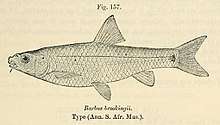Border barb
The border barb (Pseudobarbus trevelyani) is a ray-finned fish species in the family Cyprinidae.[1] It is placed with the South African redfins in Pseudobarbus. Like Pseudobarbus. It is tetraploid.[2]
| Border barb | |
|---|---|
 | |
| Scientific classification | |
| Kingdom: | Animalia |
| Phylum: | Chordata |
| Class: | Actinopterygii |
| Order: | Cypriniformes |
| Family: | Cyprinidae |
| Subfamily: | Barbinae |
| Genus: | Pseudobarbus |
| Species: | P. trevelyani |
| Binomial name | |
| Pseudobarbus trevelyani Günther, 1877 | |
| Synonyms | |
|
Barbus trevelyani | |
It is endemic to South Africa, where it has only been found in the Keiskamma and Buffalo Rivers of Eastern Cape Province, as well as their tributaries Mgqawabe and Yellowwoods Rivers.[3]
Its natural habitat are pools and riffles over rocky ground, where the freshwater streams it inhabits are clean and run through forests. It feeds chiefly on nymphs of insects, and also on other small aquatic invertebrates, plant seeds and algae. The spawning season is spring to early summer (around October–November).[3]
It is classified as Endangered by the IUCN mainly due to its restricted range. Even though it does not seem to decline markedly, its stocks are limited by African catfish (Clarias gariepinus), largemouth bass (Micropterus salmoides), smallmouth bass (Micropterus dolomieu), and trouts (Oncorhynchus and Salmo), which have been introduced in its home rivers. Also, water quality has deteriorated in modern times, and deforestation of riverbanks will drive the species from the area.[3]
References
- Froese, Rainer and Pauly, Daniel, eds. (2014). "Pseudobarbus trevelyani" in FishBase. April 2014 version.
- de Graaf et al. (2007)
- Cambray (2007)
- Cambray, J. (2007). "Barbus trevelyani". The IUCN Red List of Threatened Species. IUCN. 2007: e.T2573A9456789. doi:10.2305/IUCN.UK.2007.RLTS.T2573A9456789.en. Retrieved 11 January 2018.
- de Graaf, Martin; Megens, Hendrik-Jan; Samallo, Johannis & Sibbing, Ferdinand A. (2007): Evolutionary origin of Lake Tana's (Ethiopia) small Barbus species: indications of rapid ecological divergence and speciation. Anim. Biol. 57(1): 39–48. doi:10.1163/157075607780002069 (HTML abstract)
